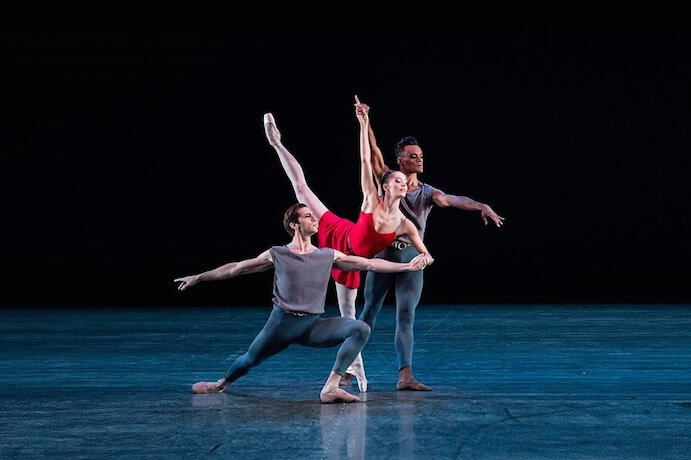If you keep waiting for the New York Philharmonic to program more new music, you need not look further for what you’re seeking than across the plaza. New York City Ballet (NYCB)’s founder George Balanchine worked closely with Igor Stravinsky on several ballets and set in motion a tradition of marrying new music with new choreography that the company has carried on since with a stalwart pride. Consisting of ballets Red Violin by Peter Martins with music by John Corigliano, Russian Seasons by Alexei Ratmansky with music by Leonid Desyatnikov, and the new ballet Dance Odyssey by Peter Walker with music by Oliver Davis, NYCB’s February 1st production of New Combinations proved an exciting and worthwhile installment of that tradition.
Shortly after John Corigliano wrote the score for François Girard’s 1998 film The Red Violin, he was commissioned to write a new work derived from that material, and in 2003 Joshua Bell premiered the Concerto for Violin and Orchestra (“The Red Violin”). Martins took a literal interpretation of the film’s plot line for his ballet Red Violin, which originally premiered in 2006. Wearing a definitive red dress, NYCB soloist Unity Phelan was effortlessly graceful and demure as the personification of the red violin. The piece is choreographed so that the female dancers are always being “handled” by their male counterparts; their arms and legs positioned by their parters, the stability usually garnered by hand-holding swapped out for grips on arms. Corigliano’s rich use of cannon and imitation was visible on stage: as a melody cascaded through instruments with a similar melody on its tail, so too did the dancers follow each other with the same choreography, one beat or step behind. While concertmaster Kurt Nikkanen gave an opulent performance of this lovely and violent piece of music, the ballet orchestra attacked the aggressive col legno battutos of the fourth movement with confidence and the aleatoric writing throughout with precision.
Composer John Corigliano (photo credit: johncorigliano.com)
The highlight of the evening was certainly Dance Odyssey, a new work by company member Peter Walker set to music by contemporary English composer Oliver Davis, scored here for solo violin, strings, piano and harp. The curtain opened to a stage lit in part by a long purple neon light that looked like it was drawn freehand across the diagonal of the back curtain. Davis’ music is filled with undulating arpeggios and perpetually unfolding harmonies reminiscent of Philip Glass while the treatment of the strings brought to mind works from a much earlier era: that of Vivaldi and Purcell. A light-hearted mood permeated the first several movements, which included a pas de deux in which the repartee between the two male dancers was one of good-naturedly one-upping each other. (A perfectly-executed moonwalk determined the winner). This overall feeling of playfulness for most of the piece made the sentimental final mood of the ballet feel all the more earnest and heartfelt. With the dancers clothed in watercolor shades of blue and purple and the neon backdrop, the ballet felt like an ethereal take on the 1950s. The humor and grace of this ballet will certainly proffer a place for it in NYCB’s standard repertoire.
Tiler Peck and Zachary Catazaro in ‘dance odyssey’–Photo by Paul Kolnik
Originally a film composer, Desyatnikov (b. 1955) has since created a wealth of music for the concert stage. His music choreographed by Ratmansky thus far practically screams of the 20th century Soviet Russian experience: the sumptuous use of the strings’ lower registers, the wailing of klezmer clarinets, the absurdist dark humor of trombone glissandi, and ravishing solo violin filigree (beautifully played by NYCB’s other concertmaster, Arturo Delmoni), all vying for our heartstrings. Ratmansky’s Russian Seasons looks and feels like some exquisite soap opera. Desyatnikov created The Russian Seasons with melodies and text from a collection of Russian folk music, and divided it into four “concertos” of three movements each a la Vivaldi. Soprano Veronica Mitina gave a solemnly haunting performance that augmented the domestic squabbles, love affairs, and public shunning all deftly discussed here by Ratmansky, whose vocabulary was by far the most extensive of the three choreographers presented on this program.
Thursday’s performance was the fourth full program of music that the orchestra had prepared and presented that week; works by Lucas Foss, William Walton, Sufjan Stevens, John Cage and others were also on the musicians’ minds and in their fingers. Perhaps the New York City Ballet orchestra is unique in its ability to perform a steady stream of intricate, detailed 20th and 21st century music at a high level, but those who choreograph for NYCB have consistently chosen contemporary music, and it is these pieces by Stravinsky, Ives, John Adams, Pärt, and others that make up the bulk of the company’s repertoire. Balanchine led by example, and thankfully so have those who followed in his dance-maker footsteps.

